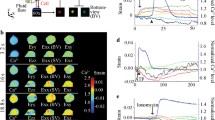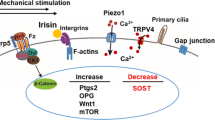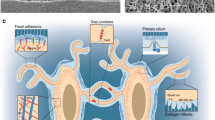Abstract:
Mechanotransduction in bone is complex in nature, being influenced by many modulators such as PTH, prostanoids, and extracellular Ca2+. It has been postulated that osteocytes, dendritic resident cells in bone, transduce signals of mechanical loading that result in anabolic responses such as the expression of c-fos, insulin-like growth factor-I (IGF-I), and osteocalcin. To date, however, neither the actual stimuli to which osteocytes respond nor the pathways of signal transduction are well understood. Cultured primary rat bone cells exhibit distinct responses to stretching depending on their developmental stages: young osteocytes that become progressively dendritic show striking responses to strain at physiological levels; these include an early response of cAMP secretion and the late responses such as the production of IGF-I and osteocalcin proteins. The upregulation of steady-state levels of their mRNA is biphasic, being preceded by two peaks of PGHS-2 (inducive prostaglandin G/H synthase; cox-2) gene expression. Compared to a typical transient immediate early expression of c-fos, PGHS-2 shows another distinct peak about 8 h after the initiation of stretching. Second peaks in IGF-I and osteocalcin expression are entirely dependent on the first wave of PGHS-2 expression judging from the inhibition by NS398. PGHS-2 is perhaps critically involved in the prolonged anabolic responses of bone "memory effect" to the osteogenic mechanical stimulation. In these cells, the extracellular Ca2+ is essential to their response to stretching. Furthermore, the blockers of stretch-activated channels, gadolinium (Gd3+), and of epithelial-like Na channels, benzamil, in combination abolish the effects of stretching such as elevated osteocalcin expression. Although voltage-operated or calcium-activated calcium channels or Na+-driven mechanisms, such as a Na–Ca exchanger, for example, are functioning, particulars of secondary Ca entry pathways are not certain at this point. It is conceivable, however, that the calcium influxes, both primary and secondary, trigger the anabolic reaction of bone to stretching via Ser/Thr kinase signaling pathways in osteocytic cells.
Similar content being viewed by others
Author information
Authors and Affiliations
Additional information
Received: Oct. 3, 1998 / Accepted: Oct. 15, 1998
About this article
Cite this article
Mikuni-Takagaki, Y. Mechanical responses and signal transduction pathways in stretched osteocytes. J Bone Miner Metab 17, 57–60 (1999). https://doi.org/10.1007/s007740050065
Issue Date:
DOI: https://doi.org/10.1007/s007740050065




